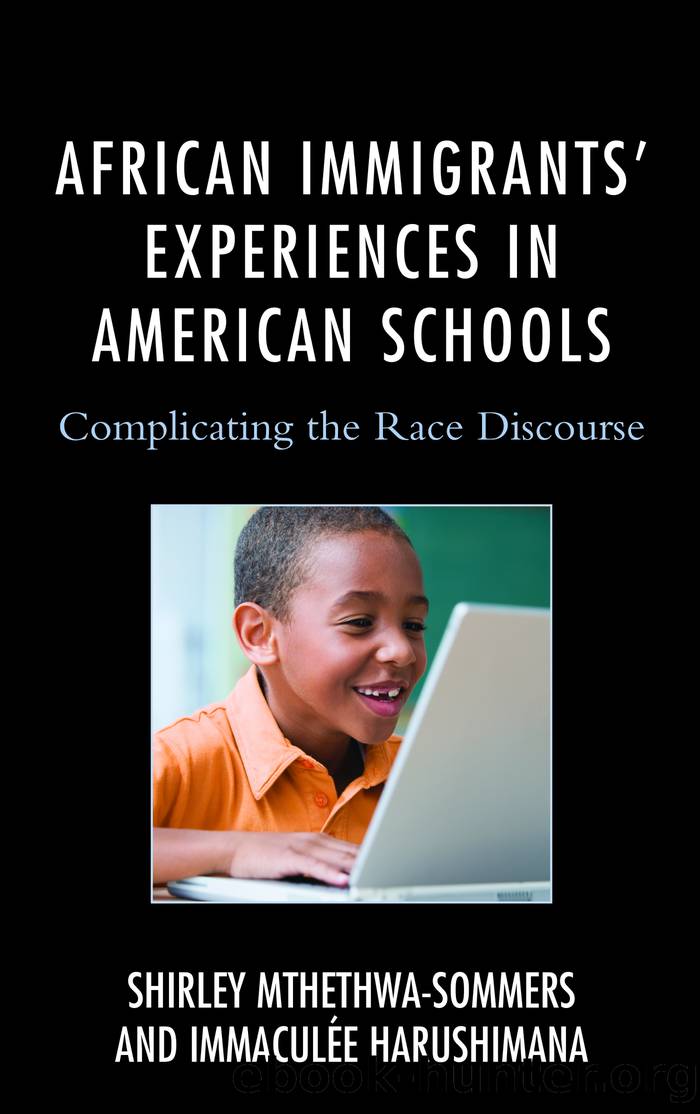African Immigrants' Experiences in American Schools by Mthethwa-Sommers Shirley;Harushimana Immaculee;

Author:Mthethwa-Sommers, Shirley;Harushimana, Immaculee;
Language: eng
Format: epub
Tags: undefined
Publisher: Lexington Books/Fortress Academic
Published: 2012-08-15T00:00:00+00:00
African-born Studentsâ Religious-based Experiences
As explained above, in postcolonial Africa, the majority of Africans practice a hybrid form of African spirituality and Christianity and/or Islam. Therefore, most African-born students live in households where both institutionalized and noninstitutionalized religions are practiced concomitantly. There is a dearth of research on how practice of either Christianity or hybridized Christianity impacts school experiences of African-born students in America. Conversely, there is growing research on African-born students who are Muslim and their experiences in schools (Basford, 2008; Mthethwa-Sommers & Kisiara, 2015). Evidence shows that practice of Islam has a deep impact on African immigrant childrenâs school adaptation. Many African-born students who identify as Muslims experience a cultural mismatch between their religion and school culture. Cultural mismatch occurs when students experience incongruity between their cultural practices and school cultural practices. It is salient to point out that African-born students who are Muslim are diverse in accordance to their countries of origin and cultural identity. As stated above, Islam practiced in African countries is informed by the individual countryâs culture, traditions, and belief systems. Therefore, there is no singular or monolithic Muslim identity. Just like Christianity has various denominations, Islam has different sects such as Sunni and Shiite, and many other sects. Additionally, some students may identify with their country of origin and not their religious affiliation. For example, a student may identify as Nigerian, or Sudanese, or Somali, even if she or he is Muslim. Nevertheless, knowledge of studentsâ religious background is essential for teachers to develop culturally informed ways of interacting. Lack of knowledge of religious tenets can be deleterious to students, as it proved to be in the case of a high school teacher who punished a female Muslim student for not wearing shorts in her gym class (Elnour & Bashal-Ali, 2003). Elnour and Bashal-Aliâs research reports that it was not until the studentâs parents reached out to the school to explain how the school requirement was not only a cultural mismatch but also inappropriate from their religious perspective that the teacher realized her mistake. While the teacher had been adamant that she treated all her students equally, she needed to understand that treating students equally was not the same as treating students equitably. School rules, which in many cases endorse Western middle-class values, are likely to be in conflict with non-Western immigrant studentsâ cultural principles. The school rule may stipulate that no students are allowed to wear hats in school, in which case a Muslim student who wears a hijab may be understood as not adhering to the school rule. Treating students equally would mean enforcing the âno hatâ rule without regard for religion; treating students equitably, in contrast, would mean enforcing the âno hatâ rule while making a provision for religious freedom and studentsâ spiritual needs. Thus, school officials need to create a school environment that makes African-born Muslim students feel integrated, as they have reported that: (a) their spiritual needs are being silenced, (b) their experiences are invisible in the curriculum, and (c) their presence is the source of American uneasiness and tension.
Download
This site does not store any files on its server. We only index and link to content provided by other sites. Please contact the content providers to delete copyright contents if any and email us, we'll remove relevant links or contents immediately.
Deep learning with TensorFlow and Keras by Derrick mwiti(867)
Understanding PDA Autism in Kids: A Guide for Parents and Teachers to Support Neurodiverse Learners by Jehu Len(720)
The Victorian Era: A Captivating Guide to the Life of Queen Victoria and an Era in the History of the United Kingdom Known for Its Hierarchy-Based Social Order by Captivating History(504)
100 Ideas for Secondary Teachers: Engaging Parents by Janet Goodall & Kathryn Weston(481)
Intersectionality in Educational Research by Dannielle Joy Davis; James L. Olive; Rachelle J. Brunn-Bevel; Susan R. Jones(478)
How to be assertive in any situation by Hadfield Sue & Hasson Gill(462)
Writing Solid Code: Development Philosophies for Writing Bug-Free Programs by Steve Maguire(460)
Brain Teasers to Build Critical Thinking Skills: Brain Exercises for Tech, Banking, Case Interview Prep, and to Keep Your Mind Sharp by Kris Safarova(454)
Brain Teasers to Build Critical Thinking Skills by Safarova Kris(452)
Python 101 - Fundamentals by Sam(416)
Critical Curriculum Leadership : A Framework for Progressive Education by Rose M. Ylimaki(411)
The Art of Emotional Validation: Improve Your Communication Skills and Transform Your Relationships by Validating Emotions and Feelings by Emily Wright(383)
The Knights Templar: An Enthralling History of the Rise and Fall of the Most Influential Catholic Military Order by Wellman Billy(370)
A Beginner's Guide to SSD Firmware by Unknown(366)
The Future Knowledge Compendium by Ellyard Peter;(365)
What Every Teacher Should Know about Learning, Memory, and the Brain by Tileston Donna E. Walker;(363)
NumPy : From Basic to Advance by bisht Karan Singh(353)
Making Connections in and Through Arts-Based Educational Research by Hala Mreiwed Mindy R. Carter Sara Hashem Candace H. Blake-Amarante(346)
Alma Maters (5th edition) by Unknown(341)
